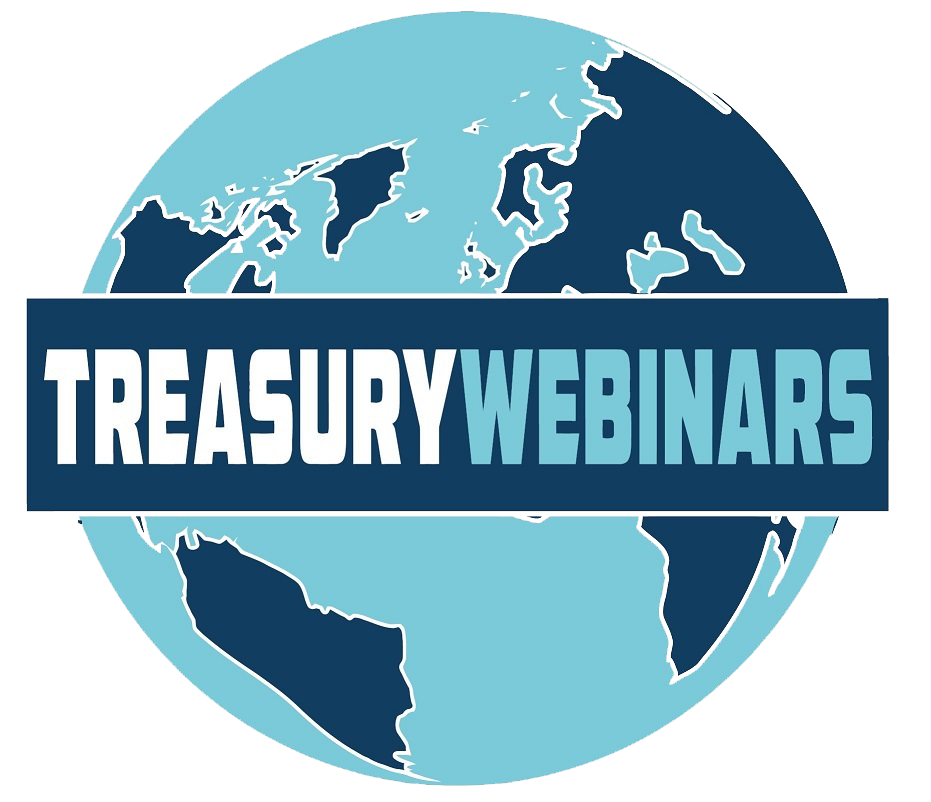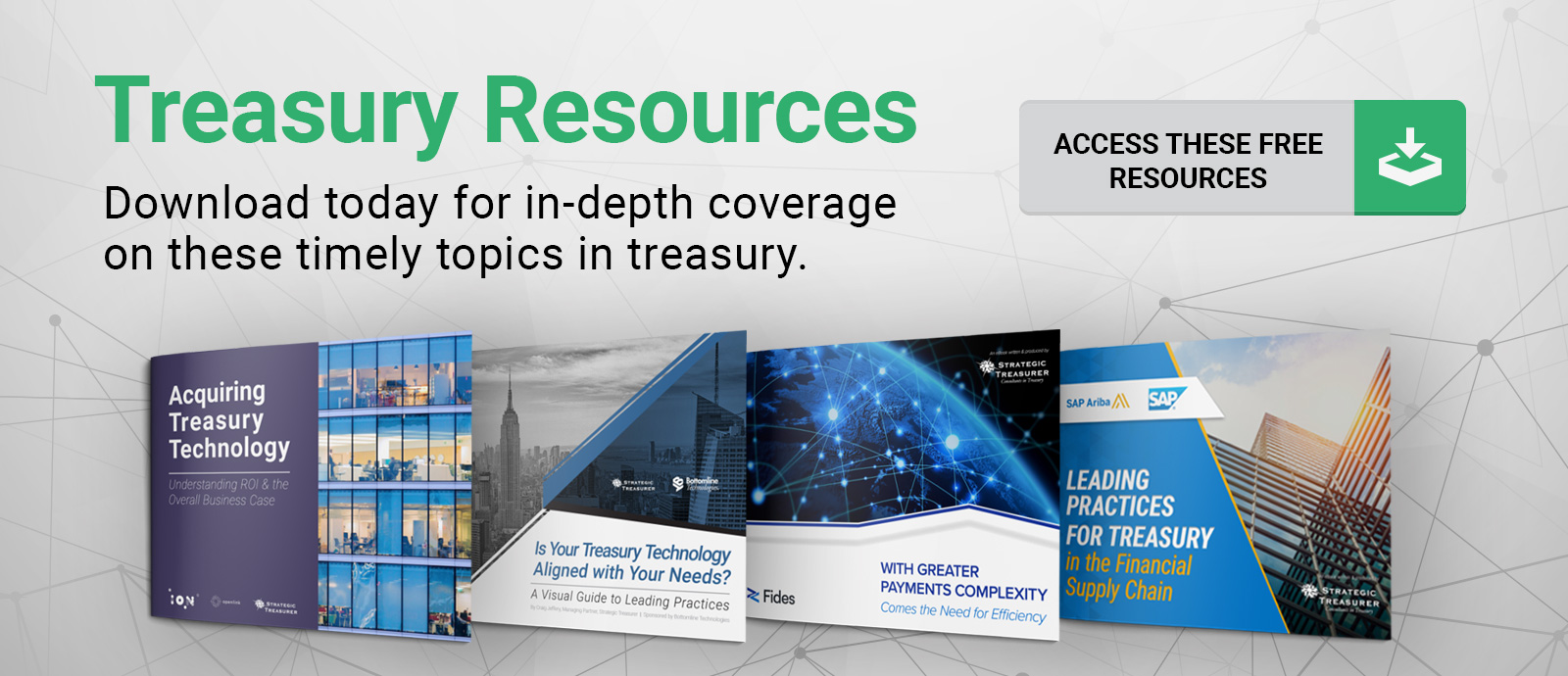
Episode 47
Owning the Cash Conversion Cycle: Relationships & Technology
On this episode of the podcast, Craig Jeffery speaks with Ernie Humphrey, CEO of Treasury Webinars on the topic of owning the Cash Conversion Cycle. With a focus on both relationships and technology, they explore how treasury, accounts payable and accounts receivable can best partner to optimize the cash convergence cycle and align KPI’s to support the overall success of organizations. Listen in to the discussion to find out more.
Host:
Speaker:
Craig Jeffery, Strategic Treasurer


Ernie Humphrey, Treasury Webinars


Episode Transcription - Owning the Cash Conversion Cycle (Treasury Webinars)
Craig Jeffery: Welcome to the Treasury update podcast. This is Craig Jeffery. I’m the managing partner of Strategic Treasurer. Today’s podcast episode is called Owning the Cash Conversion Cycle: Relationships & Technology, and I’m joined with my guests today, Ernie Humphrey. Ernie is a longtime treasury practitioner and was formerly the director of Treasury Services at the Association of Financial Professionals. He’s a prolific webinar host and speaker on Career Success of Financial Professionals and focuses on the cash conversion cycle. Welcome to the Treasury Update Podcast, Ernie.
Ernie Humphrey: Thank you very much, Craig. It’s a pleasure and honor to be here.
Craig Jeffery: Our topic today is owning the cash conversion cycle about relationships and technology, but before we get too far in on the questions, let’s begin with a few definitions. I’ll start with working capital, and then I’ll ask you to define the cash conversion cycle. So with working capital for this podcast we’re going to go with the treasury definition of working capital, which is accounts receivable plus inventory minus accounts payable. This is the amount of capital that’s used in the core operating part of the business.
Ernie Humphrey: Thanks Craig. Let me go ahead and dove tailing on your working capital definition and give us a working definition. That cash conversion cycle, I like to keep it simple. We’ll define the cash conversion cycle is the time it takes to move cash through inventory, accounts receivable and accounts payable. It’s measured in days and reflects on operational and financial efficiency. Think in terms of DIO, DSO and DPO.
Craig Jeffery: Excellent. Yeah. Days-Inventory-Outstanding, Days-Sales-Outstanding, Days-Payable-Outstanding. So we got a pretty dense subject matter here, but when we talk about who owns which parts of the cash conversion cycle, we’re talking about AR, inventory, and accounts payable. So Ernie, who typically owns these different parts of the cash conversion cycle?
Ernie Humphrey: I would say it depends, by the company. And so if you really look at most companies, there is an Accounts Payable department. And so ownership of that would be maybe your accounting manager. If you go above that, it might be the controller. If you look on the AR side of things, you’d have in accounts receivable department, you would have a credit manager, director of credit at some companies that may even go up through the risk management piece of it. And then of course treasury would oversee what we would call the cash management piece. But what I think we’re seeing now is AR and AP are starting to report up directly through treasury. And so at the end of the day, what I think we’ll see, probably five years or less, we’ll see that the ultimate ownership will be through treasury now. Now who’s really driving things in owning the efficiency will still be your accounts payable leaders and your AR leaders. What are your thoughts, Craig? What are you seeing in this area?
Craig Jeffery: We sometimes, I’ll give a definition of ownership too because that’s, I think we could dive into that a little bit. So we think of the five O’s of five O’s of cash or the five O’s of working capital. It starts off with, you know, Observe, which is more of, I can’t influence, but I can see what’s going on. There’s Oversee, which means I have some influence on what’s occurring in the cash conversion cycle, but it’s more of a convincing or an encouraging type role. And then there’s the Own, which means I can direct what needs to go on to meet the overall drivers of the business. Now the other two o’s are Oblivious. I don’t know what’s going on and then Oppressive and I don’t think we need to talk about those. But you can see the continuum of owning working capital is more than just trying to influence, but it’s, it’s directing some of those activities.
Craig Jeffery: But I think your point, I may not be as aggressive in thinking how quickly AR and AP may fall under the ownership of treasury, but certainly the data is indicating that more accounts payable departments and accounts receivable departments are either falling under the ownership of the treasurer or falling much more under the influence of the Treasury group. So, especially with technology and other parts, the same reasons you mentioned, they are influencing him in a, in a much greater level influencing it in terms of overseeing it, influencing in terms of setting the standards. No longer is a sales dictating what the payment terms are. It’s here is when we’re going to get paid, here’s when we’re going to pay, here’s what we’re going to see those things.
Ernie Humphrey: Right. And I think just to take a step back, what do I think is driving this a more ownership through treasury? I think it’s the first point you said Observe. So I think with technology we’re becoming aware. And so, you know, at Treasury we really haven’t had enough visibility into AP and Ar. And so now with the technology, AP automation, AR automation and AI, the Treasury, we start to see these things and we start to say, wow, look at the AP. Oh well why aren’t, why aren’t we taking discounts? Why aren’t we, why are we paying by checks? And then on AR, right? So I think as we start to, as more companies observe treasury, he’s going to say, hey, we know actually we are cash management. Cash management means I should own all the movements. And so that technology is facilitating our impact.
Ernie Humphrey: And so maybe we’re not going to directly own it, but how do we want to communicate with impact? Hey, let’s work with AP, right? Let’s look at their metrics. So both for AP and AR, the first step is where you’re at and where can you get to? So I talk about AP and AR done right all the time on my webinars. So AP, first thing is how much does it cost me to process? Is it process the invoice? You would be shocked. There’s a lot of low hanging fruit there. AR, how much does it cost me to process their receipt? You would be shocked. We, so we, it’s almost a process as you mentioned, it might take longer than five years, right? And we move up the chain and eventually that might lead to that direct ownership. But communicate with impact. Once AP and AR start, see, hey, we’re driving our metrics of success, we’re impacting working capital, we’re impacting the bottom line. We’re making everybody more productive. CFOs are like “Look at Treasury. You’re nailing it on all fronts. So here you go, AP and AR, you can have it.”
Craig Jeffery: The question I want to ask you, or want to hear your response on, is how can treasury, AP and AR best partner to optimize the cash conversion cycle with technology and good relationship management? And let me give you a little bit of background for that question. We talked about the Observe, Oversee and Own. So not always as AP and AR going to report to treasury directly in a dotted line relationship. And Treasury may be in an influencing position or in an ownership position, but regardless of how those things are set up, what’s the best way for them to partner to optimize the cash conversion cycle as we were describing?
Ernie Humphrey: I think the first thing that we need to do is we need to get the lay of the land right. Where are we at? How efficient are we? So if we want to be really simple, what is our DSO, right? How can we make that better? What’s impacting that? What is our DPO also? How much does it cost us to process the invoice? And how much does it cost us to process a receipt? And so, we need to see really is our house in order in terms of efficiency. And then when we look at technology, we need to look at it as an overall investment. And so that needs to go almost must go up to the CFO level. So what’s our technology strategy? So there are systems there, AP automation systems, their AR automation systems, there’s a TMS system, there’s payments systems.
Ernie Humphrey: And so we need to look at this in terms of what’s our overall technology. And so oftentimes I’ll look at AP and AR separately, and those have a justification in and of themselves. But if you start to layer in the treasury technology, the bank relationship management technology, take a step back. The first thing is let’s assess where we’re at, right? AP, where are we at returns of best in class? What we’re doing. And AP, let’s look at AR, right? And then let’s look at our treasury metrics next. Let’s look at our inventory turnover. And then let’s see where we’re at. And then we have to map these processes, all of them in excruciating detail. People, process, technology, and then the low hanging fruit will start to fall out. And so in treasury we can take the overall, we can take the lead, talk with our AP folks and map these things and look and, and let’s go to AP and say, okay, accounts payable.
Ernie Humphrey: Correct me if I’m wrong. And during this process you talked to the AP people that do things, air people, you say it looks like we have these pain points here. AR, it looks like we have these pain points here. What if we invested in this technology? We can mitigate those pain points. So the first thing is understanding the lay of the land where everyone’s coming from, get them on the same page. And then that’s look at is it a, I don’t like to use the word transformation project, but do we take this in steps? Is it AP and AR and then some treasury or let’s do it all the same and then explain to them how it all fits together. And what’s going to happen is you’ll see that the technology has benefits across all departments and that’s kind of kind of what I think. So get that lay of the land as you’re doing that, you build the relationships and then you start to see, okay, what type of technology investment do we need in? Is it, is it ROI? And then do we do it piece-by-piece or do we take the big bite out of all of it?
Craig Jeffery: Okay. So yeah, your approach is looking at technology and look at the process, the assess. But I want to ask you a little bit more about the relationship management side because even if the groups report to treasury, there’s certainly a way of dealing effectively that internal relationship management is so important to get everybody on the same page as you said. How do you go about doing that? How much of that is internal and how much you have to focus externally on the suppliers, on your customers?
Ernie Humphrey: I think they both fit together. So when I was in treasury, AP was managed in a silo. APU is the most averse to change area you could possibly have. So you have to be strategic, you have to build a relationship. So maybe that’s taking someone out to lunch or taking someone out to lunch, who’s friends with the person that’s technology averse. And so you have to tactfully take an interest in what they’re doing. So talk about what you’re doing. There’s a lot more talk about accounts payable and my treasury webinars. I’m just kinda curious what are some of the things that you guys are doing with truly takes up your time. And if you get someone talking about something that annoys them and takes up their time, then you can start to see, you know, where that low hanging fruit is for them and what their pain points are.
Ernie Humphrey: And even though they might be averse to change, if you can remove things that really irritate them, that’s a good relationship builder. So again, keep it kind of casual at first if you want to have a long-term view. Let’s start to talk about your challenges and let’s start to ease in. Well, I’ve seen this done before. Have you guys ever looked at this? Have you looked at automation? Hey, hey, I got an idea. How about you and I get lunch and let’s, let’s, let’s watch this webinar together. And so you build that consensus, you give them accountability into what that change looks like and what matters to them that you can’t let them take over the reins necessarily, but you let them have some input on what matters. The same thing on AR. Talk to the credit manager, talk to the risk manager. And so let’s, let’s really look at those and let’s not only build our relationships on a professional level, let’s see if we align personally.
Ernie Humphrey: Do our kids had the same interests? Do we go running? Do we play golf? And so let’s make those connections. And part of what AP and AR need to understand, I think a lot better is AP the interactions that you have with our suppliers matter. So you have to be cognizant of your tone and you’re on the same team and, you know, where the the more collaborative you are, the better off it’s going to be for both sides. And so we to look at this, I think AP sometimes see is this is an adversarial relationship with the suppliers. We need to explain to them the value that each and every interaction that they have. The same thing with AR, probably more so you need to be very careful on how you interact with our customers, right? They’re the ones that pay the bills.
Ernie Humphrey: So, so let’s tactfully do that as well. And then we start to connect the dots form. So this is how that all fits together. So build that relationship slowly. Whenever you’re gonna invite some sort of change, you need to get them on board and get them in the process, get them accountability, and then tell them kind of, you know, this is what’s going on. So we need to look at our suppliers and customers as partners and not adversarial and that, and that’s a huge shift. And we also want to make sure that we don’t let there are, maybe they have relationships with the next journal, a service provider. We need to make sure that they don’t let them drive. You know, what their thinking is. And so we need to make sure, and we also want to want to give them an incentive to get better. Right? Wouldn’t you like to do this? This is how things are changing and make it exciting for them.
Craig Jeffery: Yeah. Ernie, so a couple of those things, particularly in the internal side, you talked about, you know, finding out what’s going on, where their pain points are coming to alignment on those things. Something we talked about outside of this podcast so far had to do with alignment on, you know, not only goals but alignment of KPI’s. KPI’s can be very different and can work against one another. So if you’re talking to someone in procurement, their goal might be let’s save on costs and they’ll extend terms to get a better cost. And that may be great for procurement or they’re going to do some big buy and save, you know, 15% because they’re targeting a discount and that uses up a tremendous amount of capital to go into inventory. For example. What do you suggest in terms of helping to align on KPIs as well? The measurements that people use to run their business in addition to the value that you were talking about?
Ernie Humphrey: Right. So I think the first thing is that visibility into what are the KPI’s, right? Understand the incentives. And so, uh, for procurement in looking at what their metrics should be that needs to take into account the cost of capital. Our metrics can’t be in a silo. So it has to be looked at in terms of the company perspective and not just the departmental perspective in that may require a change, but that that’s the way it needs to be, right? So we need to see, uh, how do we define success? This is a whole big project, right? How do we define success in each department? And then how does that align up to our company goals? And then our company strategies. And we have to see that there’s those conflicts. So we have to get that visibility and see where these conflicts exist and we need to somehow take those out, right?
Ernie Humphrey: We all need to be on the same page. And so if you want to do this, you’re not going to get monetarily compensated on it. If you do these certain actions, you’re going to be penalized for it. And then the other thing is just being mindful of those trade-offs, right? We might put some upper or lower bounds, hey John, you can extend terms, but you can’t go beyond 45 days. That’s not gonna work. And this is why. So explaining changes that need to be made and why, but really understanding the dynamics which can get pretty complicated. But I think a lot of companies really don’t do that. And that’s why they have misalignment. They don’t look at it from every departmental goals should align up to the company’s strategic objectives and drivers of value every, every single one. And if they don’t, then we need to change those.
Craig Jeffery: Yeah, it’s easier to do. Someone sets a goal of a top and then by the time it gets down to a function there, they’re doing something different. But yeah, aligning at the top end. But as we draw to a close here on owning the cash conversion cycle, relationships in technology, we talked about a number of things in terms of who owns it, what’s changing the space. How treasury can be more active and involved with other areas, aligning goals. I just wanted to capture any final thoughts you had or any other advice or words of wisdom.
Ernie Humphrey: Just a few things and career success and treasuries about technology and relationships. And so let’s identify opportunities to create mutually beneficial relationships. If we’re going to take more ownership of that cash conversion cycle, let’s be cognizant of the impact on those and accounts payable and accounts receivable. And let’s understand the challenges that they face. Let’s build those relationships. Let’s get them to come to us for advice. And so we all need to get on the same team. So for Treasury, we need to learn how to be more social. And so we need to work on that, but that has tremendous benefits, and we need to really work together and impact performance across the enterprise and look at things in terms of the value to our company.
Craig Jeffery: Very good. Ernie, thank you for joining me on this episode of the Treasury Update Podcast. I appreciate your time and your insights.
Ernie Humphrey: Well, thank you very much, Craig. Always a pleasure to collaborate with you and your organization.



